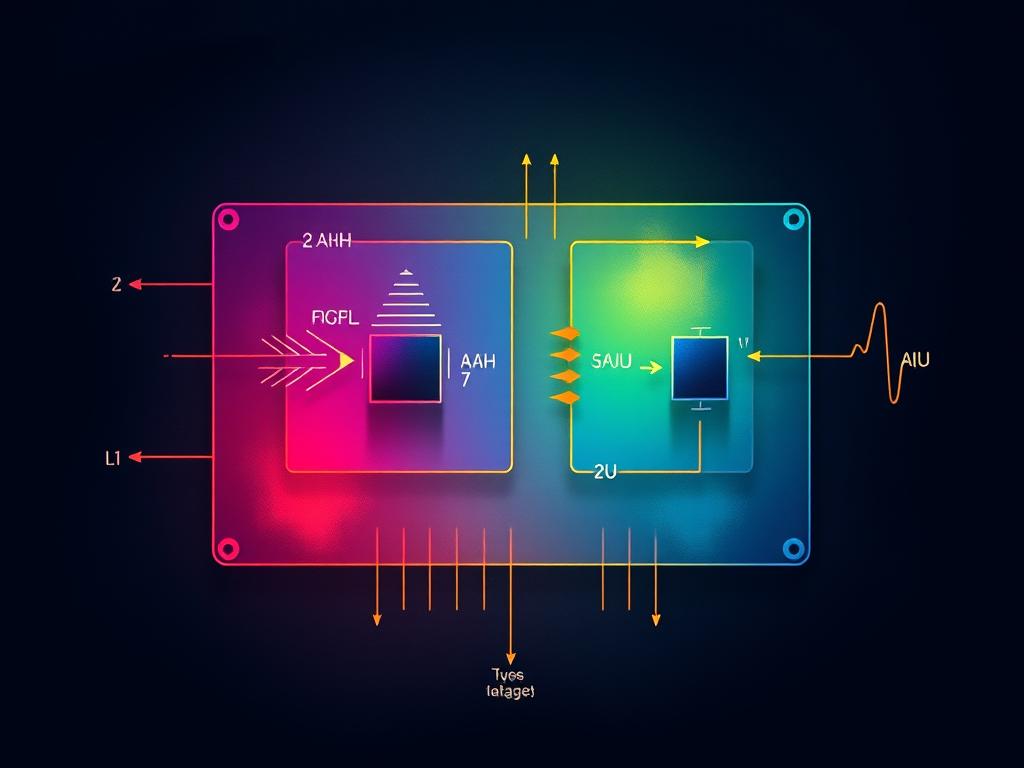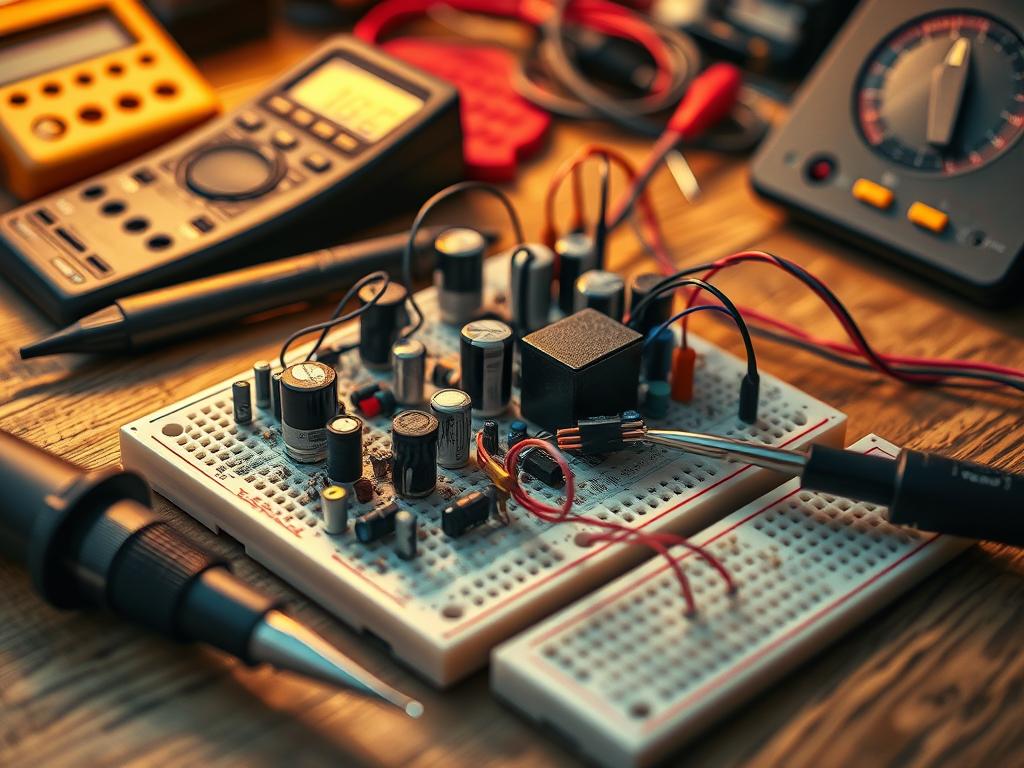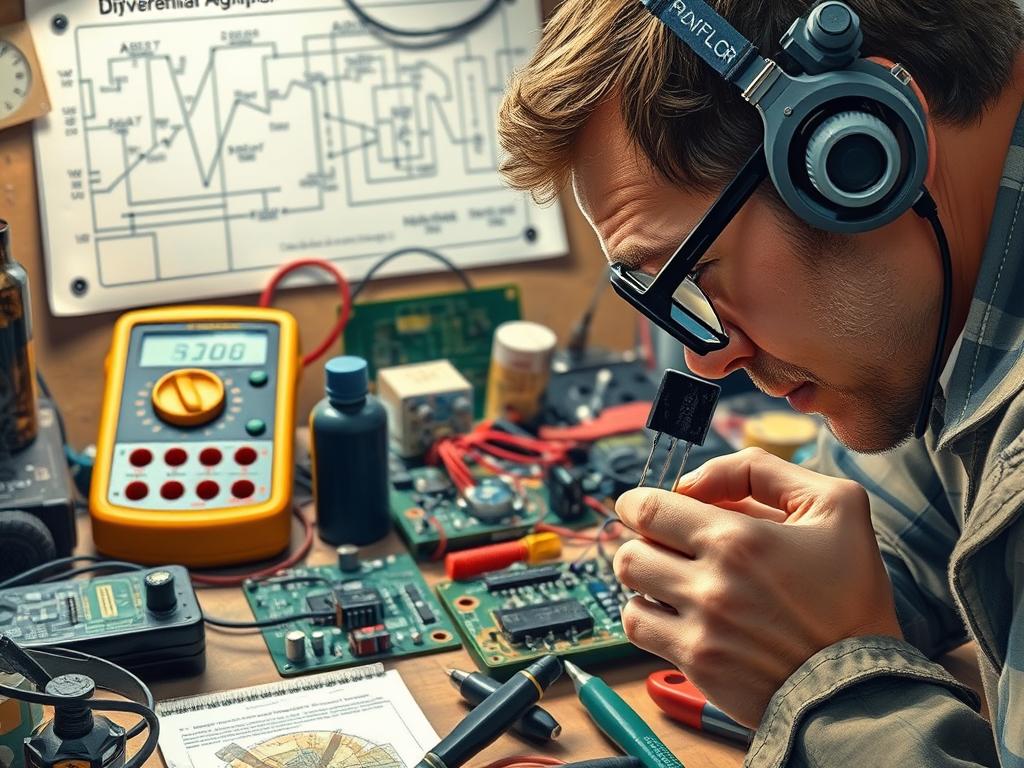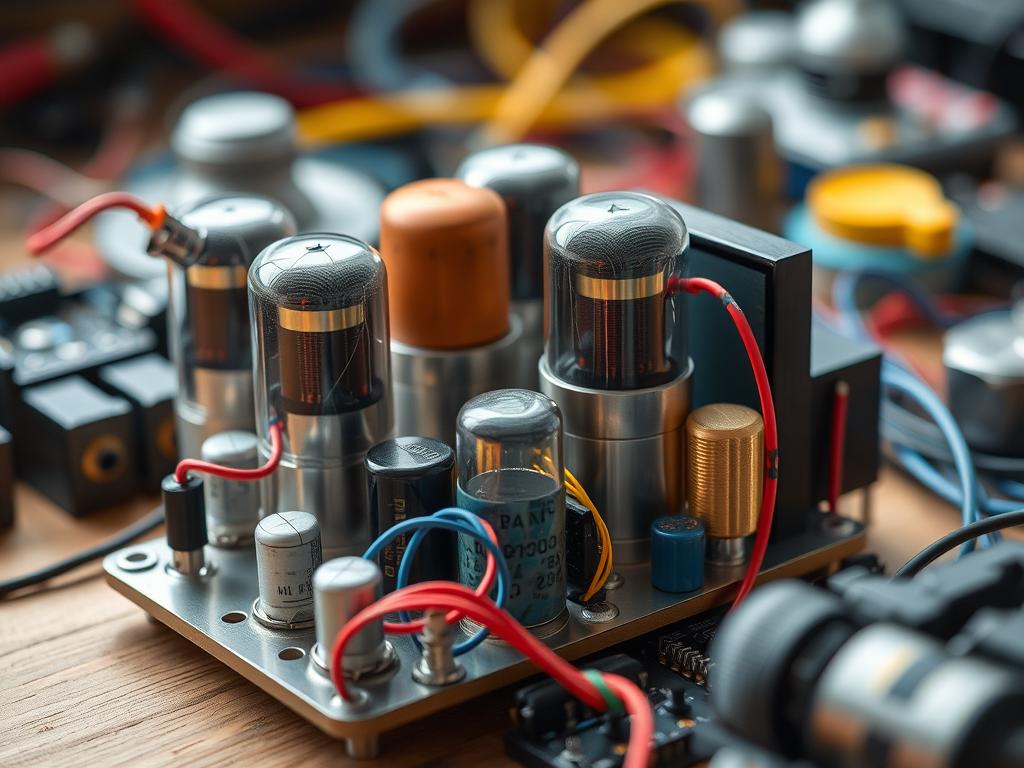Learning to make a DIY differential amplifier with transistors is key for signal processing. This guide covers how to build and understand transistor amplifier circuits. It shows how transistors help amplify the difference between two signals, ignoring common noise.
This guide teaches about important parts, circuit design, and how to put it all together. It helps you build a strong DIY differential amplifier. Knowing this boosts your skills and shows how important differential amplifiers are in many fields.
For example, they’re vital in tools and audio systems. This shows how versatile these amplifiers are in real life.
If you want to learn more, check out another guide on building a transistor radio. It’s a great way to expand your DIY skills and appreciate modern electronics.
Key Takeaways
- Understanding the principles of a DIY differential amplifier is crucial for effective analog signal processing.
- The guide provides an in-depth overview of selecting components such as transistors, resistors, and capacitors.
- Comprehensive instructions on building and testing the amplifier enhance practical skills.
- Identifies the benefits of differential amplification in reducing noise and improving signal integrity.
- Encourages exploration into various applications, including audio systems and instrumentation.
Introduction to Differential Amplifiers
A differential amplifier is a key electronic part that boosts signal processing. It amplifies the difference between two signals and ignores common noise. This makes it great for keeping signals clear, especially in noisy places. It’s used in many fields, like measuring tools and audio systems, for better analog signal processing.
What is a Differential Amplifier?
The main job of a differential amplifier is to amplify the voltage difference between two inputs. It’s good at cutting down noise, making it perfect for fast data capture. For example, in systems with analog-to-digital converters (ADCs), it helps drive signals better, leading to more efficiency and accuracy.
Importance in Electronic Circuits
Differential amplifiers are crucial in today’s electronics. They cut down noise and boost dynamic range, which is vital in audio. Audio experts value their balanced approach for clear sound. There are different ways to handle these signals, like electronic methods or transformers. For DIY projects, picking the right components is key, as shown in the importance of selecting the right transistor.
| Parameter | Value |
|---|---|
| Transistors Recommended | 2N2222, 2N3403 |
| Potentiometers Needed | 2 x 10 kΩ |
| Resistors Used | 2 x 22 kΩ, 2 x 10 kΩ, 1 x 100 kΩ, 1 x 1.5 kΩ |
| Power Supply Voltage | 12 volts |
| Adjustable Output Range | 0 to 4 volts (0 to 12 volts when bypassing resistors) |
Basic Concepts of Amplification
Amplification is key in many electronic fields. Amplifiers boost signal strength, either in voltage or current. Knowing the difference helps engineers create circuits that work well.
Voltage and Current Amplification
Voltage amplification makes input signals stronger. It’s vital for sending signals over long distances. Current amplification, however, boosts the current needed to power big loads.
Both types measure gain, showing how much power is added. Gain is the ratio of output power to input power.
Gain and Feedback Mechanisms
Gain control is crucial for signal amplification. Feedback, either positive or negative, affects an amplifier’s stability. Negative feedback improves linearity and bandwidth.
Positive feedback can cause problems if not managed. Proper use of these techniques is essential for good amplifier performance. This is true for audio systems and more. For more on operational amplifiers, check out this resource.

Components Needed for a DIY Project
Building a differential amplifier needs the right parts. You must pick transistors, resistors, and power supplies wisely. These choices affect how well the amplifier works.
Selecting the Right Transistors
Choosing the right transistors is key. You can pick from bipolar junction transistors (BJTs) or field-effect transistors (FETs). Each has its own strengths in gain, frequency, and linearity.
Think about what you need from your amplifier. Do you want high gain or low distortion? For more help, check out this guide.
Resistors and Capacitors Overview
Resistors are important for gain and stability. They control current and affect the amplifier’s gain. Capacitors filter out unwanted frequencies.
Choosing the right resistors and capacitors is crucial. It ensures your amplifier works well. Look for total harmonic distortion (THD) below 1% at 500mW per channel.
Power Supply Options
Power supplies are essential for a stable amplifier. For this project, you can use 9V at 500mA max or 12V at 700mA. But, 1000mA is best for better performance.
Good power supplies mean consistent power. Your amplifier will output 1W into 8 Ohms at 9V. It doubles to 2W into 4 Ohms. Knowing how to pick and use power sources is key for a long-lasting circuit.
Understanding Transistor Types
When designing amplifiers, knowing about BJTs and MOSFETs is key. Each has its own strengths and uses. Choosing the right one is crucial for your project.
BJT vs. MOSFET
BJTs and MOSFETs are main types of transistors. BJTs are great for high current gain and are used in many circuits. MOSFETs are known for their efficiency and are best for handling a lot of power.

Pros and Cons of Each Type
Knowing the good and bad of BJTs and MOSFETs helps you make better choices. Here’s a quick guide:
| Transistor Type | Pros | Cons |
|---|---|---|
| BJT |
|
|
| MOSFET |
|
|
Choosing between BJTs and MOSFETs depends on your project’s needs. Think about bandwidth, power, and circuit design. For more on BJTs, check out this guide on bipolar transistors. Understanding these transistors helps you build better electronic projects.
Schematic of a Basic Differential Amplifier
The differential amplifier schematic is key to understanding how different parts work together. Each part is important for amplifying signals. Knowing these parts well helps in making the circuit work better.
Overview of Circuit Design
A basic differential amplifier has several main parts:
- Transistors – These are crucial for the amplifier’s performance, like gain and input impedance.
- Resistors – They help set the circuit’s bias points and control the current flow.
- Capacitors – Used for passing and blocking signals in the amplifier.
Explanation of Each Component
Knowing each part helps in designing a better differential amplifier:
| Component | Function |
|---|---|
| Transistors | They are the main amplifiers, often used in fully differential configurations for better performance. |
| Resistors | They ensure the circuit runs smoothly and stably. |
| Capacitors | They keep the circuit stable and filter out noise. |
When designing a differential amplifier, pay close attention to details. Avoiding too much current and using a logical design approach is key. Using both PMOS and NMOS improves the circuit’s performance in different situations.
Building Your Differential Amplifier
Building a differential amplifier requires careful steps for the best results. Paying attention to details can help avoid mistakes. This guide will walk you through the process and highlight common errors to watch out for.
Step-by-Step Assembly Instructions
- Gather Materials: Make sure you have all the parts, like the THS4631 op-amp and resistors and capacitors. Choose high-quality components for better performance.
- Design the Circuit: Look at the schematic to see where each part goes. Plan out the circuit layout carefully.
- Prepare the PCB: Clean and get ready the PCB for parts. Be careful with polarized components.
- Component Placement: Start putting parts on, beginning with small ones like resistors. Check the schematic for correct placement.
- Soldering: Solder each connection carefully to avoid mistakes. Keep your hand steady for strong connections.
- Testing Connections: Do resistance tests before turning on the amplifier. This checks for short circuits.
- Power the Circuit: Turn on the amplifier and check how it works.
Common Mistakes to Avoid
- Incorrect Biasing: Wrong biasing can mess up the amplifier. Use a multimeter to check bias levels.
- Component Placement Errors: Wrongly placed parts can get damaged. Double-check the layout and schematic before soldering.
- Inadequate Grounding: A good ground connection is key. Avoid ground loops and ensure solid grounding.
- Overheating: Don’t solder too long without letting parts cool. This can damage them.
- Neglecting to Test: Skipping tests can hide problems. Always check connections and parts.

Testing Your Amplifier
Testing a differential amplifier is key to its performance. You need the right tools for accurate measurements. Oscilloscopes and multimeters are essential for this task.
These tools help see how the amplifier works. They check if it meets the design goals.
Tools Needed for Testing
Here are the tools you need for differential amplifier testing:
- Oscilloscope: This tool lets you see the output signals. It shows the signal’s shape, frequency, and amplitude.
- Multimeter: It measures DC voltages and currents. This confirms if the circuit is working right.
- Signal Generator: It sends known signals to the amplifier. This helps analyze its gain and performance.
Analyzing Output Signals
Seeing the waveform is just the start. You need to analyze the signals deeply. Look at these important metrics:
- Gain Measurement: Compare the output voltage to the input voltage. This shows if the amplifier amplifies signals as needed.
- Frequency Response Analysis: Check how the gain changes with frequency. This finds the amplifier’s critical frequencies.
- Distortion Evaluation: Look for any distortion in the waveform. It can show if the amplifier is not working right.
Knowing about devices like the 2N3904 NPN transistor helps. Its voltage and current ratings are important for signal quality. For better testing and component picking, check out guidelines on selecting transistors.
Troubleshooting a Differential Amplifier
Fixing amplifier problems is key to making differential amplifiers work well. Issues like distortion, low output voltage, and instability can happen. Knowing how to find and fix these problems is important.
Identifying Common Issues
There are several problems that can happen with differential amplifiers. It’s important to know these issues to solve them:
- Distortion of Output Signal: This is often due to mismatched parts or wrong setup.
- Low Gain: Faulty transistors or not enough supply voltage can cause this.
- Instability: Wrong feedback or parasitic capacitances can lead to this.
- Incorrect Single Supply Usage: A single-supply circuit can act strangely if not designed right.
Fixing Circuit Errors
To solve amplifier problems, you need to check and adjust carefully. Here are ways to fix common errors:
- Check Component Values: Make sure all resistors and capacitors match the circuit design, especially with precision parts.
- Inspect Power Supply Connections: Check if the power supply voltage is correct and connections are tight. Using dual rail supplies can help a lot.
- Utilize Virtual Ground: A virtual ground can help in single-supply setups, especially with operational amplifiers like the LM324.
- Monitor Offset Levels: Check input offset current and voltage to find any DC performance issues.

Finally, reviewing the circuit setup is crucial. Different setups can give different results. Make sure the differential amplifier is set up right for its purpose to avoid many common problems.
| Issue | Potential Cause | Possible Fix |
|---|---|---|
| Distortion of Output Signal | Mismatched components | Replace with matched parts |
| Low Gain | Inadequate supply voltage | Use a dual rail power supply |
| Instability | Improper feedback | Adjust feedback network |
| Incorrect Single Supply Usage | Improper circuit design | Implement virtual ground |
Advanced Differential Amplifier Designs
Exploring advanced differential amplifier designs opens up many possibilities. Techniques like current mirrors and cascading amplifiers help improve performance. They allow for better gain while keeping stability in various applications.
Current Mirrors and their Applications
Current mirrors are key in advanced amplifier designs. They help achieve stable biasing and better performance. Current sources are usually between 10 to 20 mA, crucial for circuit delivery.
The Beta24 fully differential power amplifier shows how current mirrors enhance gain. Adjusting quiescent current levels is vital for efficiency.
Cascading Amplifiers for Increased Gain
Cascading amplifiers increase gain in differential amplifier designs. They use complementary MOSFETs in cascoded configurations. This method allows for effective operation on a single-polarity DC supply.
Understanding input and output common mode range and open loop gain is crucial. Designers can find innovative approaches in IEEE papers on low voltage CMOS operational amplifiers.
| Specification | Value |
|---|---|
| Supply Voltage (VDD) | 2V |
| Closed Loop Gain | 2 |
| Dynamic Range at Output | >80 dB |
| Settling Error | |
| Settling Time | |
| Load Capacitance | 10 pF |
| Phase Margin | > 60 Degrees |
| Power Dissipation | Low |
Building these circuits incrementally is safe and easy. Using resistors between 1 kΩ and 100 kΩ helps. Logical designs ensure the output stays usable.
For those interested in active filters, exploring related resources can offer valuable insights.
Applications of Differential Amplifiers
Differential amplifiers are key in many electronic fields, especially in instrumentation and audio systems. They boost small signal differences while cutting down on noise. This makes them crucial in today’s tech world.
Use in Instrumentation Applications
Instrumentation amplifiers are a special kind of differential amplifier. They shine in medical tools, sensor connections, and data gathering systems. They make readings more precise by amplifying tiny voltage differences from sensors.
This precision is key for accurate measurements. Their high common mode rejection ratio (CMRR) helps keep out environmental noise. This is super important where signal quality matters most.
Role in Audio Systems
In audio, differential amplifiers are vital for both pros and hobbyists. They boost audio signals and get rid of unwanted noise, keeping sound clear. They reject common-mode signals like hum and interference, giving a cleaner sound.
These amplifiers handle multiple outputs well and keep the audio quality top-notch. They’re essential for clear, high-fidelity sound. Their role in audio tech shows how important differential amplifiers are.
| Application | Description | Key Feature |
|---|---|---|
| Instrumentation | Amplifies small differential signals in noisy environments | High common mode rejection ratio |
| Audio Systems | Enhances audio signals while rejecting noise | Maintains audio clarity |
| Medical Devices | Improves accuracy in diagnostic readings | Precision signal processing |
| Data Acquisition | Facilitates accurate data collection from sensors | Minimizes signal distortion |
Want to learn more about differential amplifiers? Check out the chapter on transistor differential amplifier circuits. For more, see Hands-On Electronics.
Understanding the Gain Equation
The amplifier gain equation is key to understanding differential amplifiers. Knowing how to use this equation helps in designing better amplifier circuits. This part explains how to get the gain formula and its practical uses.
Derivation of the Gain Formula
The output of a differential amplifier is given by:
Vout = Ad • (V2 – V1)
In this formula, Ad is the amplifier’s gain. It’s found by:
Ad = Vout / (V2 – V1)
With equal resistors, the gain Ad becomes simpler:
Ad = RC / RE
This shows that gain depends on the collector to emitter resistor ratio. Temperature, frequency, and load impedance also affect gain.
Applications of Gain Calculations
Calculating gain is vital for choosing the right components. It ensures the amplifier works well. The common-mode rejection ratio (CMRR) is important, especially in instruments.
Practical uses of gain include:
- Designing amplifiers that meet voltage needs.
- Fixing performance problems through fault analysis.
- Improving signal processing in devices.
Building and analyzing circuits also helps understand these concepts better.
Enhancements and Modifications
Improving a differential amplifier design often means adding new features. This includes using filters to cut down on unwanted noise. These changes can greatly improve how well the amplifier works and the quality of the sound it produces.
Adding Filters and Noise Cancelation
Using noise filtering techniques is key to reducing distortion and keeping the signal clear. Balanced circuits help fight common mode noise and make signals clearer. Adding capacitors to power supply lines can also help by blocking high-frequency noise.
It’s important to test and adjust these filters. Changing resistor values can help make them work better. This ensures the amplifier gets the best results without losing signal quality.
Optimizing Performance with Feedback
Adding feedback loops is another way to make a differential amplifier better. Negative feedback helps keep the gain stable, improves linearity, and cuts down on distortion. Feedback loops compare the output to the input, helping to fine-tune the amplifier’s performance.
Using different types of feedback networks lets engineers customize the amplifier’s features. For example, adjusting transistor balance pots can reduce unwanted signal feedthrough. This makes the amplifier work even better.

These upgrades and tweaks take a basic differential amplifier to the next level. They add advanced features needed for top-notch audio and signal processing. For tips on fixing these enhancements, check out this link.
Conclusion and Final Thoughts
The journey through differential amplifiers has shown their key role in electronics. We’ve learned about the differential gain equation and how it works. We also see the importance of components like the LM741 operational amplifier in designing systems.
Exploring more in electronics is crucial for those who want to learn more. Advances in semiconductor technology improve device performance, like the LTC6406. By trying out new circuit designs, engineers can find practical uses for their work.
Studying differential amplifiers helps engineers and tech fans understand circuit design better. For more on bipolar power transistors in audio amps, check out this guide.


